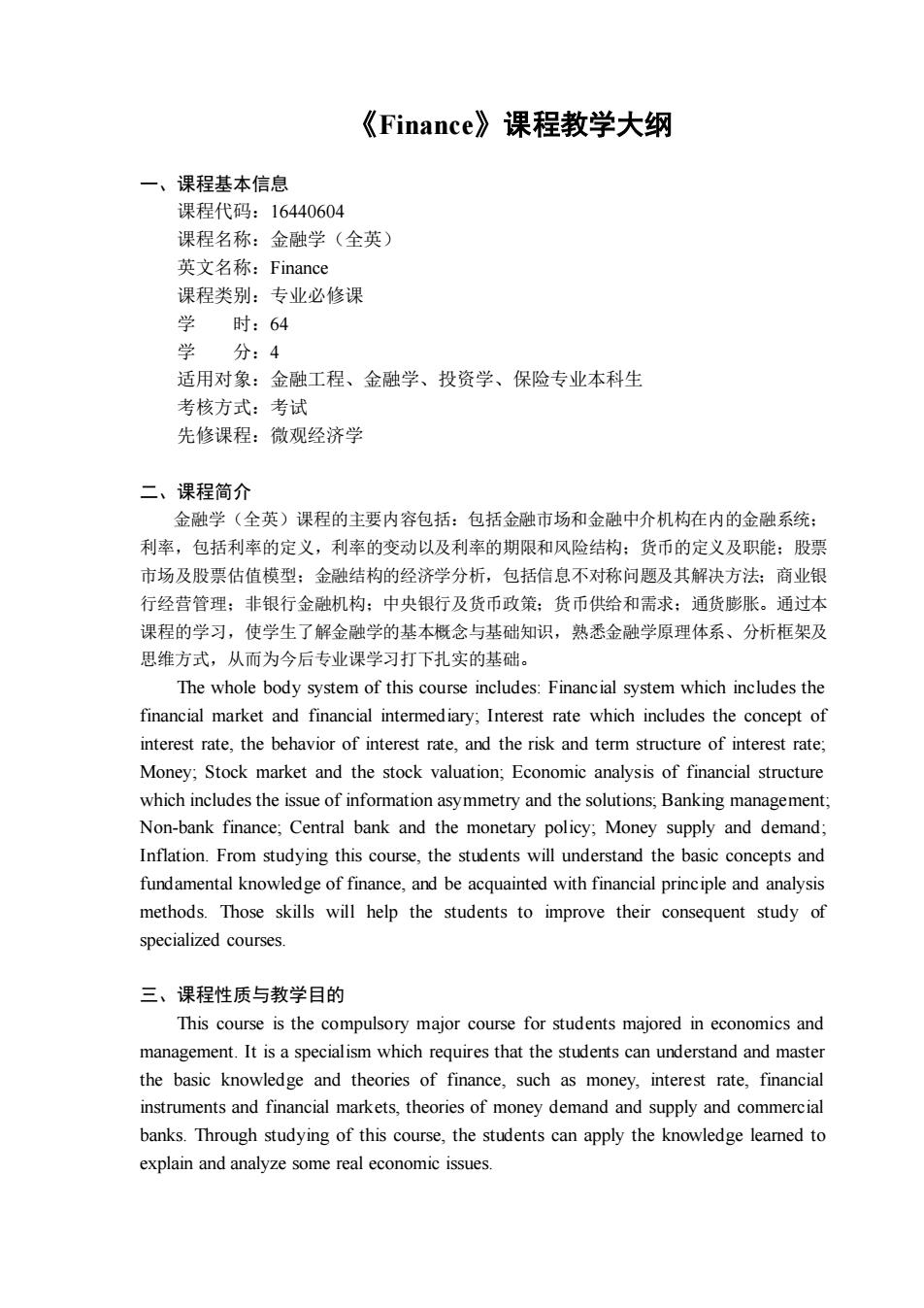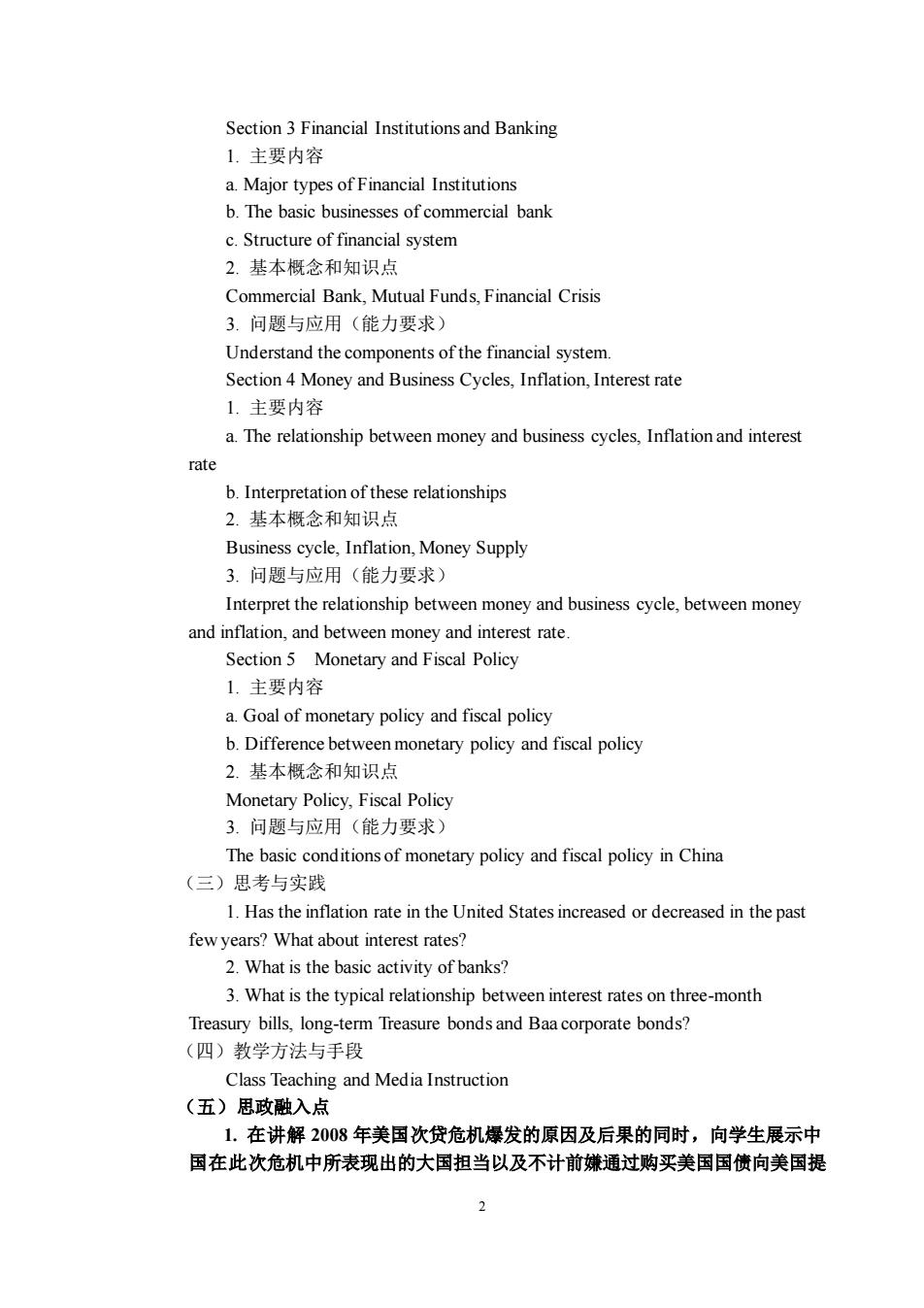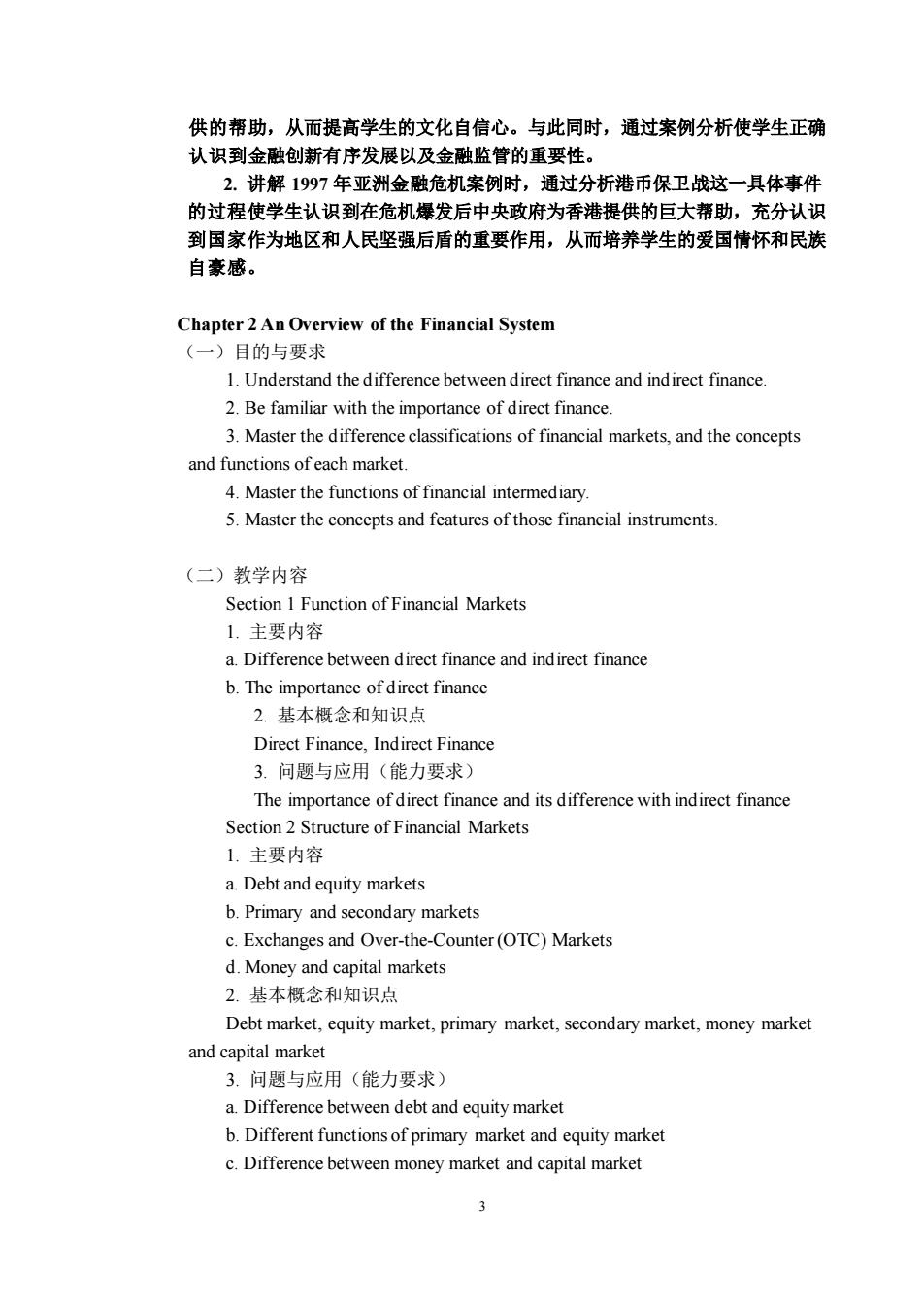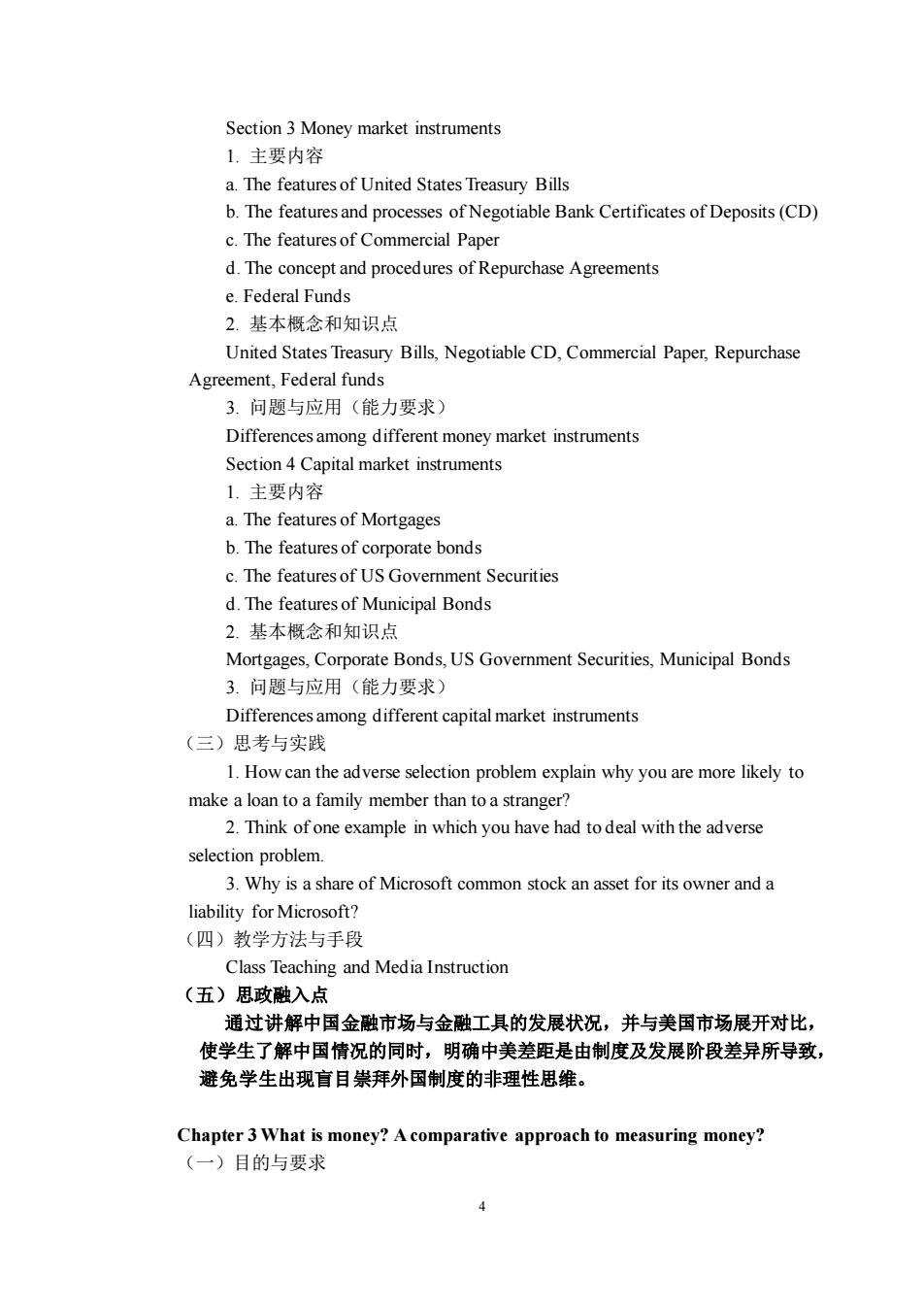
《Finance》课程教学大纲 一、课程基本信息 课程代码:16440604 课程名称:金融学(全英 英文名称:Finance 课程类别:专业必修课 学时:64 学 分:4 适用对象:金融工程、金融学、投资学、保险专业本科生 考核方式:考试 先修课程:微观经济学 二、课程简介 金融学(全英)课程的主要内容包括:包括金融市场和金融中介机构在内的金融系统: 利率,包括利率的定义,利率的变动以及利率的期限和风险结构:货币的定义及职能:股票 市场及股票估值模型:金融结构的经济学分析,包括信息不对称问题及其解决方法:商业银 行经营管理:非银行金融机构:中央银行及货币政策:货币供给和需求:通货膨胀。通过本 课程的学习,使学生了解金融学的基本概念与基础知识,熟悉金融学原理体系、分析框架及 思维方式,从而为今后专业课学习打下扎实的基础。 The whole body system of this course includes:Financial system which includes the financial market and financial intermediary:Interest rate which includes the concept of interest rate,the behavior of interest rate,and the risk and term structure of interest rate. Money:Stock market and the stock valuation,Economic analysis of financial structure which includes the issue of information asymmetry and the solutions;Banking management; Non-bank finance:Central bank and the monetary policy:Money supply and demand: Inflation.From studying this course,the students will understand the basic concepts and fundamental knowledge of finance,and be acquainted with financial principle and analysis methods.Those skills will help the students to improve their consequent study of specialized courses 三、课程性质与教学目的 This course is the compulsory major course for students majored in economics and management.It is a specialism which requires that the students can understand and master the basic knowledge and theories of finance,such as money,interest rate,financial instruments and financial markets,theories of money demand and supply and commercial banks.Through studying of this course,the students can apply the knowledge leamed to explain and analyze some real economic issues
《Finance》课程教学大纲 一、课程基本信息 课程代码:16440604 课程名称:金融学(全英) 英文名称:Finance 课程类别:专业必修课 学 时:64 学 分:4 适用对象:金融工程、金融学、投资学、保险专业本科生 考核方式:考试 先修课程:微观经济学 二、课程简介 金融学(全英)课程的主要内容包括:包括金融市场和金融中介机构在内的金融系统; 利率,包括利率的定义,利率的变动以及利率的期限和风险结构;货币的定义及职能;股票 市场及股票估值模型;金融结构的经济学分析,包括信息不对称问题及其解决方法;商业银 行经营管理;非银行金融机构;中央银行及货币政策;货币供给和需求;通货膨胀。通过本 课程的学习,使学生了解金融学的基本概念与基础知识,熟悉金融学原理体系、分析框架及 思维方式,从而为今后专业课学习打下扎实的基础。 The whole body system of this course includes: Financial system which includes the financial market and financial intermediary; Interest rate which includes the concept of interest rate, the behavior of interest rate, and the risk and term structure of interest rate; Money; Stock market and the stock valuation; Economic analysis of financial structure which includes the issue of information asymmetry and the solutions; Banking management; Non-bank finance; Central bank and the monetary policy; Money supply and demand; Inflation. From studying this course, the students will understand the basic concepts and fundamental knowledge of finance, and be acquainted with financial principle and analysis methods. Those skills will help the students to improve their consequent study of specialized courses. 三、课程性质与教学目的 This course is the compulsory major course for students majored in economics and management. It is a specialism which requires that the students can understand and master the basic knowledge and theories of finance, such as money, interest rate, financial instruments and financial markets, theories of money demand and supply and commercial banks. Through studying of this course, the students can apply the knowledge learned to explain and analyze some real economic issues

At the same time,the students can understand the differences existing between China's capital market and foreign capital market,form the rational ideas about these differences and avoid having the irrational idea of blind worship.Also,the students can correctly understand the current international status of China,and the important effects played by China,cultivating students'national sense of pride and national self-confidence. 四、教学内容及要求 Chapter 1 Why Study Money,Banking,and Financial Markets? (一)目的与要求 1.Understand the basic knowledge framework of Finance Major,and understand the structure of the teaching book. 2.Understand the goal of learning finance. 3.Be familiar with the concept of financial market and its basic classification. 4.Be familiar with the concept of financial institutions,and the features of banks 5.Be familiar with the relationships between money and business cycles, inflation and interest rates 6.Understand the concepts of monetary and fiscal policy,and the differences between these two policies (二)教学内容 Section 1 Why Study Money,Banking,and Financial Markets? 1主要内容 a.The importance of leamning this course b.The basic learning structure of this course. 2.基本概念和知识点 Money,Banks,Financial Markets 3.问题与应用(能力要求) Understand the recent development of financial market and commercial banks. Section 2 Financial Markets 1,主要内容 a.Major types of financial markets b.The relationship between bond and interest rate c.Different types of stock 2.基本概念和知识点 Bond Market,Stock Market,Common Stock,Interest Rate 3.问题与应用(能力要求) Understand the difference between bond market and stock market
1 At the same time, the students can understand the differences existing between China’s capital market and foreign capital market, form the rational ideas about these differences and avoid having the irrational idea of blind worship. Also, the students can correctly understand the current international status of China, and the important effects played by China, cultivating students’ national sense of pride and national self-confidence. 四、教学内容及要求 Chapter 1 Why Study Money, Banking, and Financial Markets? (一)目的与要求 1. Understand the basic knowledge framework of Finance Major, and understand the structure of the teaching book. 2. Understand the goal of learning finance. 3. Be familiar with the concept of financial market and its basic classification. 4. Be familiar with the concept of financial institutions, and the features of banks. 5. Be familiar with the relationships between money and business cycles, inflation and interest rates. 6. Understand the concepts of monetary and fiscal policy, and the differences between these two policies. (二)教学内容 Section 1 Why Study Money, Banking, and Financial Markets? 1. 主要内容 a. The importance of learning this course b. The basic learning structure of this course. 2. 基本概念和知识点 Money, Banks, Financial Markets 3. 问题与应用(能力要求) Understand the recent development of financial market and commercial banks. Section 2 Financial Markets 1. 主要内容 a. Major types of financial markets b. The relationship between bond and interest rate c. Different types of stock 2. 基本概念和知识点 Bond Market, Stock Market, Common Stock, Interest Rate 3. 问题与应用(能力要求) Understand the difference between bond market and stock market

Section 3 Financial Institutions and Banking 1.主要内容 a.Major types of Financial Institutions b.The basic businesses of commercial bank c.Structure of financial system 2基本概念和知识点 Commercial Bank,Mutual Funds,Financial Crisis 3.问题与应用(能力要求) Understand the components of the financial system. Section 4 Money and Business Cycles,Inflation,Interest rate 1.主要内容 a.The relationship between money and business cycles.Inflation and interest rate b.Interpretation of these relationships 2.基本概念和知识点 Business cycle,Inflation,Money Supply 3.问题与应用(能力要求】 Interpret the relationship between money and business cycle,between money and inflation,and between money and interest rate Section5 Monetary and Fiscal Policy 1.主要内容 a.Goal of monetary policy and fiscal policy b.Difference between monetary policy and fiscal policy 2.基本概念和知识点 Monetary Policy,Fiscal Policy 3.问题与应用(能力要求) The basic conditions of monetary policy and fiscal policy in China (三)思考与实践 1.Has the inflation rate in the United States increased or decreased in the past few years?What about interest rates? 2.What is the basic activity of banks? 3.What is the typical relationship between interest rates on three-month Treasury bills,long-term Treasure bonds and Baa corporate bonds? (四)教学方法与手段 Class Teaching and media instruction (五)思政融入点 1.在讲解2008年美国次贷危机爆发的原因及后果的同时,向学生展示中 国在此次危机中所表现出的大国担当以及不计前嫌通过购买美国国债向美国提 2
2 Section 3 Financial Institutions and Banking 1. 主要内容 a. Major types of Financial Institutions b. The basic businesses of commercial bank c. Structure of financial system 2. 基本概念和知识点 Commercial Bank, Mutual Funds, Financial Crisis 3. 问题与应用(能力要求) Understand the components of the financial system. Section 4 Money and Business Cycles, Inflation, Interest rate 1. 主要内容 a. The relationship between money and business cycles, Inflation and interest rate b. Interpretation of these relationships 2. 基本概念和知识点 Business cycle, Inflation, Money Supply 3. 问题与应用(能力要求) Interpret the relationship between money and business cycle, between money and inflation, and between money and interest rate. Section 5 Monetary and Fiscal Policy 1. 主要内容 a. Goal of monetary policy and fiscal policy b. Difference between monetary policy and fiscal policy 2. 基本概念和知识点 Monetary Policy, Fiscal Policy 3. 问题与应用(能力要求) The basic conditions of monetary policy and fiscal policy in China (三)思考与实践 1. Has the inflation rate in the United States increased or decreased in the past few years? What about interest rates? 2. What is the basic activity of banks? 3. What is the typical relationship between interest rates on three-month Treasury bills, long-term Treasure bonds and Baa corporate bonds? (四)教学方法与手段 Class Teaching and Media Instruction (五)思政融入点 1. 在讲解 2008 年美国次贷危机爆发的原因及后果的同时,向学生展示中 国在此次危机中所表现出的大国担当以及不计前嫌通过购买美国国债向美国提

供的帮助,从而提高学生的文化自信心。与此同时,通过案例分析使学生正确 认识到金融创新有序发展以及金融监管的重要性。 2.讲解1997年亚洲金融危机案例时,通过分析港币保卫战这一具体事件 的过程使学生认识到在危机爆发后中央政府为香港提供的巨大帮助,充分认识 到国家作为地区和人民坚强后盾的重要作用,从而培养学生的爱国情怀和民族 自豪感。 Chapter 2 An overview of the financial system (一)目的与要求 1.Understand the difference between direct finance and indirect finance. 2.Be familiar with the importance of direct finance. 3.Master the difference classifications of financial markets,and the concepts and functions of each market 4.Master the functions of financial intermediary. 5.Master the concepts and features of those financial instruments. (二)教学内容 Section 1 Function of Financial Markets 1主要内容 a.Difference between direct finance and indirect finance b.The importance of direct finance 2.基本概念和知识点 Direct Finance.Indirect Finance 3.问题与应用(能力要求) The importance of direct finance and its difference with indirect finance Section 2 Structure of Financial Markets 1.主要内容 a.Debt and equity markets b.Primary and secondary markets c.Exchanges and Over-the-Counter(OTC)Markets d.Money and capital markets 2.基本概念和知识点 Debt market,equity market,primary market,secondary market,money market and capital market 3.问题与应用(能力要求) a.Difference between debt and equity market b.Different functions of primary market and equity market c.Difference between money market and capital market 3
3 供的帮助,从而提高学生的文化自信心。与此同时,通过案例分析使学生正确 认识到金融创新有序发展以及金融监管的重要性。 2. 讲解 1997 年亚洲金融危机案例时,通过分析港币保卫战这一具体事件 的过程使学生认识到在危机爆发后中央政府为香港提供的巨大帮助,充分认识 到国家作为地区和人民坚强后盾的重要作用,从而培养学生的爱国情怀和民族 自豪感。 Chapter 2 An Overview of the Financial System (一)目的与要求 1. Understand the difference between direct finance and indirect finance. 2. Be familiar with the importance of direct finance. 3. Master the difference classifications of financial markets, and the concepts and functions of each market. 4. Master the functions of financial intermediary. 5. Master the concepts and features of those financial instruments. (二)教学内容 Section 1 Function of Financial Markets 1. 主要内容 a. Difference between direct finance and indirect finance b. The importance of direct finance 2. 基本概念和知识点 Direct Finance, Indirect Finance 3. 问题与应用(能力要求) The importance of direct finance and its difference with indirect finance Section 2 Structure of Financial Markets 1. 主要内容 a. Debt and equity markets b. Primary and secondary markets c. Exchanges and Over-the-Counter (OTC) Markets d. Money and capital markets 2. 基本概念和知识点 Debt market, equity market, primary market, secondary market, money market and capital market 3. 问题与应用(能力要求) a. Difference between debt and equity market b. Different functions of primary market and equity market c. Difference between money market and capital market

Section 3 Money market instruments 1.主要内容 a.The features of United States Treasury Bills b.The features and processes of Negotiable Bank Certificates of Deposits(CD) c.The features of Commercial Paper d.The concept and procedures of Repurchase Agreements e.Federal Funds 2.基本概念和知识点 United States Treasury Bills,Negotiable CD,Commercial Paper,Repurchase Agreement.Federal funds 3.问题与应用(能力要求 Differences among different money market instruments Section4 Capital market instruments 1.主要内容 a.The features of Mortgages b.The features of corporate bonds c.The features of US Government Securities d.The features of Municipal Bonds 2.基本概念和知识点 Mortgages,Corporate Bonds,US Government Securities,Municipal Bonds 3.问题与应用(能力要求) Differences among different capital market instruments (三)思考与实践 1.How can the adverse selection problem explain why you are more likely to make a loan to a family member than to a stranger? 2.Think of one example in which you have had to deal with the adverse selection problem. 3.Why is a share of Microsoft common stock an asset for its owner and a liability for Microsoft? (四)教学方法与手段 Class Teaching and Media Instruction (五)思政融入点 通过讲解中国金融市场与金融工具的发展状况,并与美国市场展开对比, 使学生了解中国情况的同时,明确中美差距是由制度及发展阶段差异所导致 避免学生出现盲目崇拜外国制度的非理性思维。 Chapter 3 What is money?A comparative approach to measuring money? (一)目的与要求 4
4 Section 3 Money market instruments 1. 主要内容 a. The features of United States Treasury Bills b. The features and processes of Negotiable Bank Certificates of Deposits (CD) c. The features of Commercial Paper d. The concept and procedures of Repurchase Agreements e. Federal Funds 2. 基本概念和知识点 United States Treasury Bills, Negotiable CD, Commercial Paper, Repurchase Agreement, Federal funds 3. 问题与应用(能力要求) Differences among different money market instruments Section 4 Capital market instruments 1. 主要内容 a. The features of Mortgages b. The features of corporate bonds c. The features of US Government Securities d. The features of Municipal Bonds 2. 基本概念和知识点 Mortgages, Corporate Bonds, US Government Securities, Municipal Bonds 3. 问题与应用(能力要求) Differences among different capital market instruments (三)思考与实践 1. How can the adverse selection problem explain why you are more likely to make a loan to a family member than to a stranger? 2. Think of one example in which you have had to deal with the adverse selection problem. 3. Why is a share of Microsoft common stock an asset for its owner and a liability for Microsoft? (四)教学方法与手段 Class Teaching and Media Instruction (五)思政融入点 通过讲解中国金融市场与金融工具的发展状况,并与美国市场展开对比, 使学生了解中国情况的同时,明确中美差距是由制度及发展阶段差异所导致, 避免学生出现盲目崇拜外国制度的非理性思维。 Chapter 3 What is money? A comparative approach to measuring money? (一)目的与要求